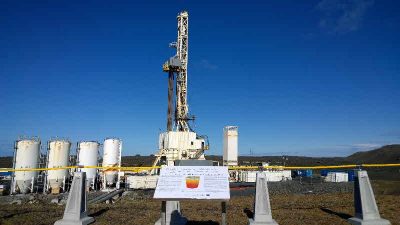Iceland magma geothermal project may revive giant UK power cable link
 Magma geothermal well can produce 5 to 10 times more energy compared to conventional geothermal
Magma geothermal well can produce 5 to 10 times more energy compared to conventional geothermal
Magma from deep beneath the earth may hold the key to generating up to 10 times more energy than from a conventional geothermal well, according to Icelandic and international researchers.
The $100 million Krafla Magma Testbed project is being coordinated by Iceland’s Geothermal Research Group (GEORG) and the British Geological Survey, with the participation of 38 institutes and companies from 11 countries including the United States, Canada and Russia.
Producing geothermal energy from magma would enable Iceland to export more energy and could also revive a plan to build a power cable from Iceland to Britain to provide power to British homes, in what would be the world’s longest power interconnector, according to Reuters.
Iceland, a volcanic island that produces all its electricity from geothermal energy and hydropower, agreed with Britain last year to study building the 1,000-km long IceLink cable, which could power 1.6 million British homes.
Those plans were delayed due to Britain’s vote to leave the European Union and concern in Iceland that exports would increase power prices at home and reduce the island’s attractiveness to energy-intensive industries such as data centers.
Drilling of the IDDP-2 Project was completed in mid-January at a depth of 4,650 meters, according to a press release from HS ORKA, an Iceland utility and one of the project proponents.
The objective was to drill deep, extract drilling cores, measure the temperature and search for permeability. Temperature at the bottom of the well has already been measured at 427C and the pressure at 340 bars, and drilling cores have been retrieved.
It´s clear that at the bottom of the well the fluid has reached supercritical conditions,” said the utility. “Never before has it been explored what lies beneath the geothermal field at Reykjanes.”
The first phase of the project was drilling to 3,000 meter depth and casing the well with a steel casing and cementing it firmly in the surrounding formations, the deepest well casing job undertaken yet for an Iceland geothermal well.
“This [project] would open new dimensions in geothermal utilization if it would be possible to source supercritical fluid, which has a much higher energy content than conventional high-temperature geothermal steam,” says the utility.
“Based on the estimated pressure levels in the well it might be possible to produce 30-50 MW from this well, which is substantially more than from regular geothermal wells.”
Potential utilization will not be known until the end of year 2018 when all research has been conducted, but first indications are positive.
“The (possibility of increasing geothermal energy supply in Iceland) would most certainly be a boost to the proposed (IceLink) plan as there were worries on the effect on local prices with increased exports,” Wayne Bryan, an analyst at the British Alfa Energy consultancy, told Reuters.
Britain’s National Grid would continue to look into the Icelandic interconnector link, a spokeswoman said.
The collaboration is seeking to raise US$30 million for the first drilling phase to make the research facilities available to the scientific community by 2020. The facilities would be open to the international science community for a 30-year-programme of research, including repeated probing and sampling of the magma body, the British Geological Survey said in a statement on Friday about the study.
“Krafla is the only place in the world where we can pinpoint the exact location of a magma chamber: making it the best and only place on Earth to do this. It is also among the most researched volcanoes in the world, and therefore one we know most about,” said Volcanology professor John Eichelberger, University of Alaska Fairbanks.
“What we know about magma comes from interpreting activity measured at the surface, the geology of fossil magma chambers, and laboratory experiments. The Krafla drilling project will provide direct samples and observations, helping the world to read signs of volcanic unrest better.”









